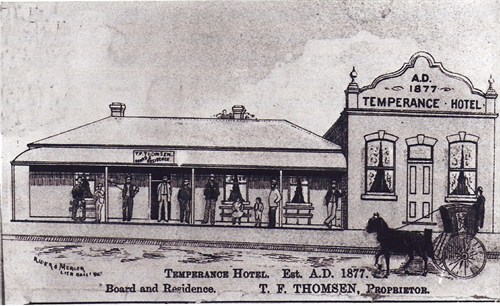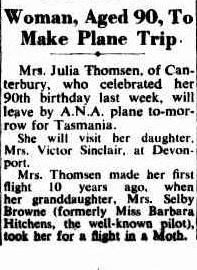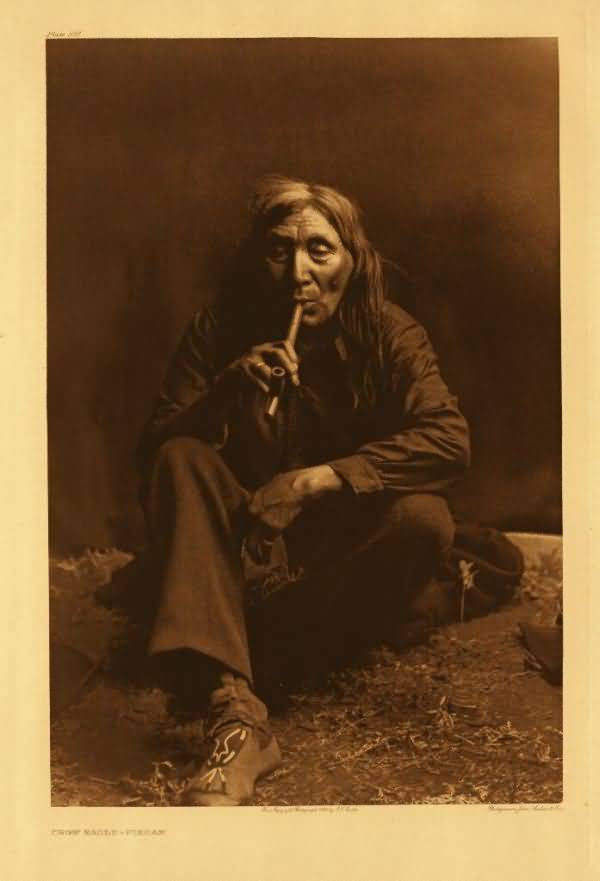
The Young Julia Duncan
I have loved this picture of my great grandmother Julia Duncan for as long as I can remember. It inspired in me a desire to find out more about her, and in fact was the catalyst for starting my journey into family history more than 37 years ago. I have recorded what I know of this extraordinary woman and hope that you enjoy getting to know her.
Julia Duncan was registered as Julia Dunker in Tamworth, New South Wales in 1858, although she was actually born at Nundle which was a gold fields village just 50 kilometres to the south east. Her father and mother would have arrived in Nundle at some time before her birth in October of 1858. Reef gold had been found in Nundle in 1852 although alluvial gold had been found in the area as much as three years earlier ie: late 1840’s. Julia’s father was listed as a mining warden in Nundle at the time of her birth, however it is thought that he went into the building trade, obtaining his timber from along the edges of Duncan’s Creek.
Life in the area at the time was not easy although most of life’s necessities were available to Julia’s family. Some basic vegetables such as potato, pumpkin and cabbage were essentially unavailable at any cost though, a situation whereby the greater population living in the area were existing on meat and bread alone.
Julia would have spent her early years running and playing with children whose families had emigrated to the area from many different parts of the world. We know that this little girl was living in the gold fields area until at least the middle of 1864, at which time her mother, whilst pregnant with her 5th child, left her father taking all the children with her. Julia was just 5 1/2 years old.
Julia spent time growing up near the Bective Church which is situated on the hill at Bective, a property outside of Tamworth, and also on a property (Terrible Vale) at Uralla where her step father worked. As Julia grew she was known to have beautiful long, brown hair and she took particular care to wash it regularly. She would use a solution of water and a small amount of honey to rinse her hair in. This solution allowed Julia to style her hair into a bun or plait and feel confident that there would not be a hair out of place. I’m wondering if this was a precursor to hairspray!!
On 5 Jun 1879 in Tamworth Julia married Henry Watts Bailey and by 1884 Julia, Henry and their 3 children – Sarah, Edward and Herbert were living in Singleton, New South Wales. The young family’s life in Singleton was very difficult with Henry unable to find work. Julia’s feelings of love for her husband are documented in numerous newspaper reports relating to Henry’s suicide in 1885; she was heartbroken.

L to R: Edward, Sarah & Herbert Bailey
Julia showed strength and courage in equal portions during this time, moving the children moved back to Tamworth after Henry’s death and taking up work as a boarding house keeper at the Temperance Hotel (boarding house) to support them all. The boarding house appears to have consisted of two buildings joined by a common wall. On the Bourke Street side is a wide frontage building with ridge capping parallel to Peel Street. On the Darling Street side is a taller and narrow fronted building of greater depth than the former with ridge capping at right angels to Peel street. The Temperance Hotel was built in 1877 but there is no record of it’s builder, owner or first proprietor. Either at first, or through later additions, the Hotel had 21 rooms. It is during this period of her life that she met a Salvation Army Minister and Farmer by the name of Franz Frederick Thomsen (known as Frank). They married on 28 Oct 1889, going on to have 6 children together – Sophia, Florence, Frederick, Hans, Alice & Aubrey. There is a lithograph picture which shows the boarding house bearing Mrs Thomsen’s name, although they have her name wrong it should read J. Thomsen Proprietor, or J & F Thomsen at the very least!

Temperance Hotel
Through my grandfather I know that whilst Julia was a strong woman, she was also a loving and devoted mother to all of her nine children. She and her second husband Frank Thomsen shared both their faith and many happy times together, until his death in 1920. After Frank’s death Julia lived for while with my grandparents Edward Thomas & Ines Maude Bailey in Broughton Street, Croydon and also her daughter Florence Edith McCabe nee: Thomsen.
Julia made headlines in newspapers at the age of 90 years, when she flew with her grand daughter, aviatrix Barbara Alice Hitchins, to Tasmania to visit family. Even in her old age Julia displayed her courage, determination and adventurous spirit – qualities that shone at various times throughout her long life.

The Sydney Morning Herald. Saturday 6 Nov 1948, page 9
The following notice appeared in the funeral notices of a Sydney Newspaper
Mrs Julia Thomsen
formerly of Westdale
Mrs Julia Thomsen died at the residence of her daughter, Mrs McCabe, Kensington, at the age of 95 years. She is survived by her children Annie, Edward, Herbert, Sophia, Florence, James, Alice and Aubrey. William died some years ago, also her husband, Mr Frank Thomsen. Mrs Thomsen resided at Bective for many years, and later at Westdale, where she worked unceasingly for the Salvation Army. She spent her last years with her family in Sydney. She is buried at Rookwood Cemetery. Captain Lucas of the Salvation Army conducted the services.
This slideshow requires JavaScript.
Sources:
Lyle Green Papers – Tamworth Historical Society
Tamworth Historical Society Archives
TROVE Digitised Newspapers – Australian Town and Country, Saturday 16 Apr 1892
NSW Dept. of Primary Industries
Personal Memories of Charlotte Beatson nee: Duncan (now deceased)






















You must be logged in to post a comment.